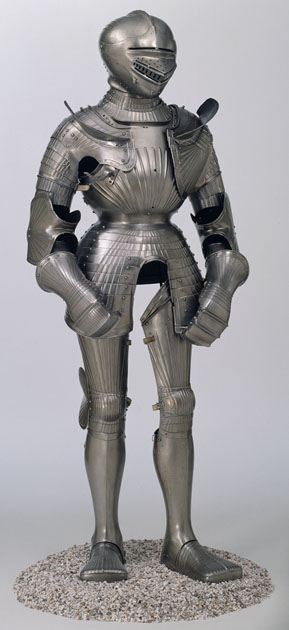Details
- Object type
breastplate
- Place Associated
Germany (place of manufacture)
- Date
circa 1510
- Materials
steel, leather
- Description
-
This style of armour was produced in the arms-manufacturing towns of southern Germany in the first few decades of the 16th century. It is often referred to as ‘Maximilian’ due to the fact that early armour collectors believed that the Holy Roman Emperor Maximilian I had personally invented the style. Although this is unlikely, it is known that the emperor took a keen interest in armour production. Not only did he patronise some of the finest armourers in Europe, he also had a set of gilded armourers’ hammers made for him.
The large rounded forms are decorated with fluting. These are ridges hammered into the steel and further accentuated with incised lines. This probably reflects the civilian fashion for slashed clothing and wide-toed footwear. Note that the greaves (lower leg defences) are plain. This could be because the armourer was trying to simulate the look of the plain silk stockings worn at the time.
Many of the surviving armours of this type are composites. That is, composed of pieces from various armours as well as later additions. This splendid example (with the exception of the gauntlets which were made a few years later) is complete with none of these later additions. The best quality steel made from Alpine iron ore has been used to create this armour. It would have provided excellent protection against the various weapons encountered on the European battlefield including, increasingly, smaller firearms.
- Credit Line/Donor
Bequeathed by R L Scott, 1939
- Collection
R L Scott Collection
- ID Number
E.1939.65.j.1
- Location
In storage
